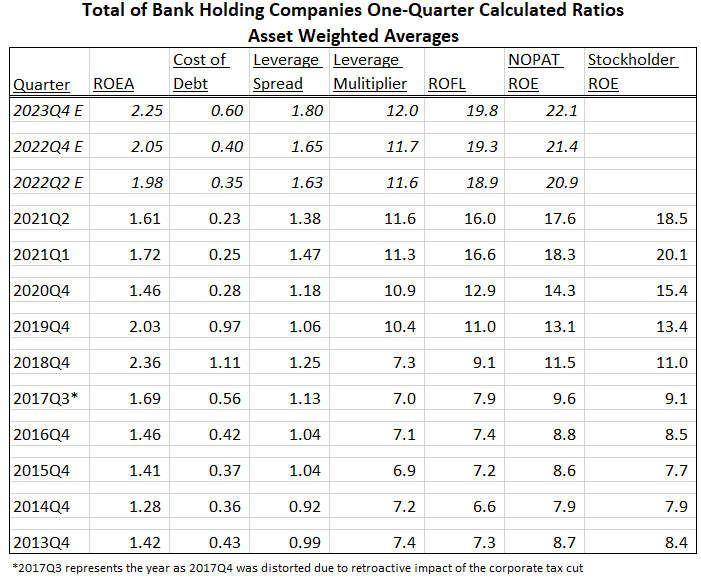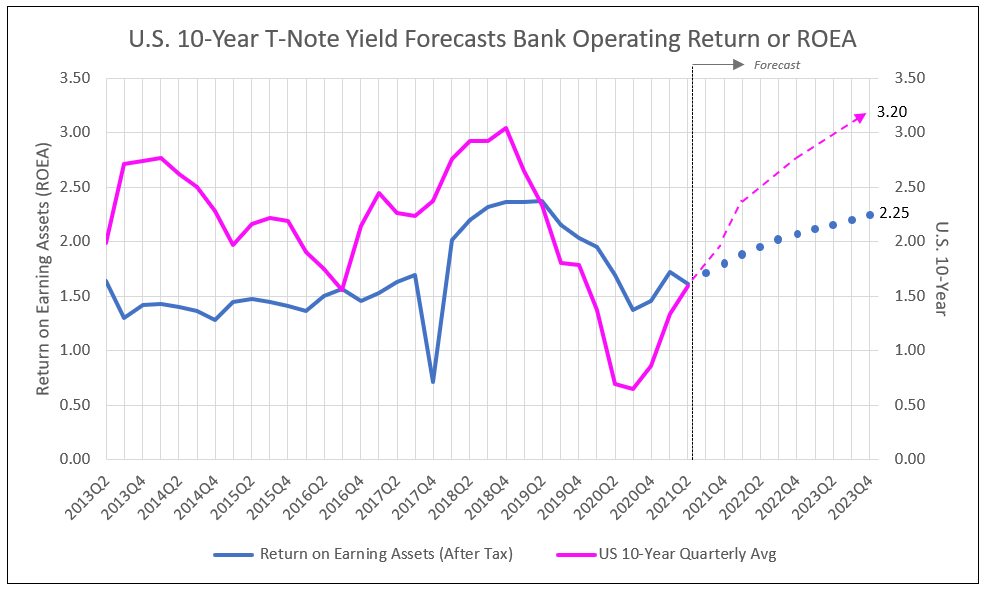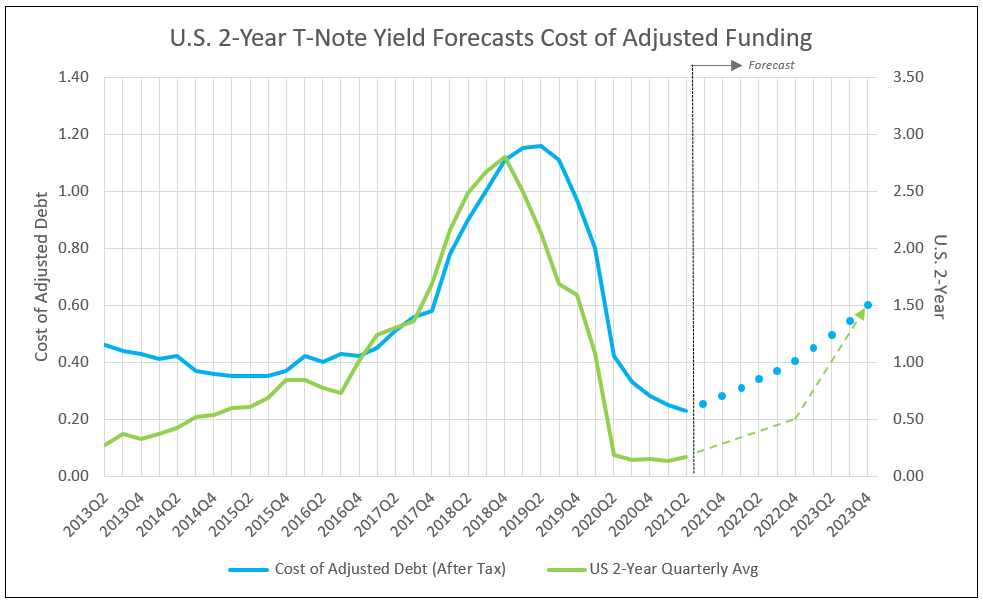The Profit Structure of Banking Improves Dramatically
Providing the Fundamentals for a Bull Market in Bank Stocks
Return on Equity (ROE) defines the profit structure of the banking industry. ROE is defined by IDC Financial Publishing (IDCFP) as the addition of return on earnings assets (ROEA) and return on financial leverage (ROFL), or operating return plus financial return.
ROEA equals all operating income, less operating expenses (before funding costs) after-tax, excluding the loan loss provision, but adding back the increase in the loan loss reserve, to capture operating performance. Operating returns experienced a rising trend over the past decade. ROEA rose from an all-bank average of 1.46% in 2016 to a peak of 2.37% in June of 2019 and ended 2019 at 2.03%. Covid-19 impact last year reduced ROEA to 1.46% in December of 2020, but it is expected to recover to 1.98% by the second quarter of 2022, then to as high as 2.05% by year-end 2022 and 2.25% in 2023.
Return on Financial Leverage (ROFL) experienced a dramatic acceleration from 7.4% in 2016 to 16.0% in early 2021. ROFL in a function of the leverage spread times the leverage multiplier. Leverage spread is the above described ROEA less the interest cost of adjusted debt, after tax. Leverage multiplier is the ratio of adjusted debt divided by the sum of tangible equity capital and the loan loss reserve. Adjusted debt equals the amount of earning assets not funded by tangible equity capital and the loan loss reserve.
While ROEA grew from 1.46% in 2016 to 1.61% in the second quarter of 2021, cost debt rose from 0.42% in 2016, to a peak of 1.16% in early 2019, but fell to 0.23% in the second quarter of 2021 due to Covid-19 and Federal Reserve policies. As ROEA recovers in 2021 through 2023, cost of debt will increase to 0.35%, then to an estimated 0.40% and 0.60% during the same period. Leverage spread, therefore, increases to 1.63% in the second quarter of 2022, and to 1.65% at year-end 2022 and 1.80% in 2023 (see Table I and Charts I, II and III).
The key change in the last 5 years was the increase in the leverage multiplier from 7.1 in 2016 to 11.6 in the second quarter of 2021 (see Chart III). The significant rise in leverage, multiplied by an improving leverage spread, dramatically increased ROFL from 7.4% in 2016 to 16.0% by mid-2021. Adding the ROEA to ROFL provided an increase in profitability (ROE) from 8.8% in 2016 to 17.6% in the second quarter of 2021. In the same period, stockholder ROE rose from 8.5% to 18.5%.
NOPAT ROE (ROEA + ROFL) measures the true cash flow return on tangible equity and the loan loss reserve. Stockholder ROE calculates profitability adjusted for loan loss expense changes to forecast risk. Using NOPAT ROE, the forecast for 2022 through 2023 improves with a ROE to 20.9% by mid-2022, then 21.4% by year-end 2022 and 22.1% in 2023.
As tangible equity per share grows at 15% and ROE increases from 17.6% to 22.1%, earnings per share growth accelerates. This earnings per share acceleration with a terminal p/e ratio of 14-times, provides the substantial appreciation potential through 2023, a long bull market in bank stocks.
Table I

Banks Benefit from Multiple Forms of Leverage in this Economic Recovery
The combined effect of bank leverage forecasts a 72% price appreciation based on a revised target price of 225 for the index of large banks (BKX) over the next year, and additional appreciation for the remainder of 2022 and the year 2023.
Leverage from a Higher NOPAT ROE Less Cost of Equity Capital Drives a Rising Price to Tangible Book Value
Estimating appreciation potential for a bank stock requires a target price.
- Projection of tangible book value per share (TBVPS) one year into the future.
- Forecast of NOPAT ROE one year ahead.
- Forecast of cost of equity capital (COE) based on the 30-year T-Bond yield one year ahead, with COE adjusted for bank-specific risk.
The spread between ROE and COE determines the projected price-to-book, which is multiplied by forecast TBVPS to calculate the target price.
IDCFP’s Forecast Process
Due to these multiple forms of leverage in a recovering economy with rising yields, bank stocks outperform value stocks, as represented by the Russell 1000 value stock index. In past bull markets in bank stocks, IDC Financial Publishing (IDCFP) forecasts proved accurate. For example, the BKX* over 20 months, from 6/30/2016 to 2/22/2018, rose to 103.6% of the target price for February 2018. The price appreciation over 20 months was 97.1% and the forecast for the price appreciation was 92.0%. Our forecast for the target price today uses the same process as in past years. *BKX: Large Money Center, Regional and Credit Card Banks
For a more detailed graphic of IDCFP’s Common Stockholder Net Operating Profit (After tax) ROE Equation please contact us. Individual bank valuations also available upon request.
Chart I

Chart II

Chart III

Methodology:
IDC Financial Publishing (IDCFP) nontraditional approach to financial ratios, modeling, forecasting, and valuation offer a unique prospective to bank stock selection.
The Traditional ROE Equation and the Problem with the Bank Stock Analysis
The traditional ROE equation simply divides net income by the average of common stockholder’s tangible equity capital. The stockholder ROE, as a bottom-line measure of profitability, fails to reflect the true nature of asset value. In addition, the traditional components of the ROE ratio – net interest margin, net income return on assets (ROA), and resulting stockholder ROE – confuse the source of net income by subtracting cost of funding so early in the analysis. Bank common stock evaluation is unable to separately compare operating and financial returns. Also, accounting for the loan loss provision, and not adjusting net income for the increase on the loan loss reserve, fails to reflect the true cash flow to earnings.
The NOPAT ROE Equation and ROEA, a Measure of Operating Returns
In contrast (IDCFP) uses the NOPAT ROE equation to express ROE as a sum of two components, operating return (ROEA) and financial return (ROFL). ROEA equals the return that the bank earns on loans, securities, cash equivalents and other earning assets, after operating expenses and taxes, before the loan loss provision and interest expenses on the deposit and debt funds, but adds back the increase in the loan loss reserve. ROEA focuses on the operating strategy, which identifies returns from investments, loans, and non-interest income sources net of expenses and taxes, plus the increase in the loan loss reserve, all as a percent of earning assets.
Return on Financial Leverage (ROFL), a Measure of Financial Returns
The second component is the bank’s return on financial leverage (ROFL). This reflects both the degree to which the bank uses deposit and debt funds to finance its operating strategy and the cost of these debt funds. A bank’s return on financial leverage (ROFL) measures the efficiency with which the bank uses deposits, borrowings, and other forms of debt to leverage or fund earning assets, not funded by tangible equity capital and the loan loss reserve. ROFL is the product of the bank’s ‘leverage spread” and “leverage multiplier.”
The leverage spread is the difference between the after-tax ROEA and the after-tax cost of funding. The after-tax cost of funding equals interest expenses divided by the net adjusted debt.
Adjusted debt (equal to total earning assets less tangible equity capital and the loan loss reserve) is the remaining amount of earning assets funded by deposits, borrowings, or other debt. The leverage multiplier is the ratio of adjusted debt divided by the sum of tangible equity capital and the loan loss reserve.
The addition of the operating return (ROEA) plus the financial return (ROFL) equals the net operating profit (after tax) return on equity (NOPAT ROE).
Cost of Equity Capital equals the long T-Bond yield forecast, plus ½ times that yield times the risk factor for the individual bank.
General Disclosure
IDC Financial Publishing, Inc. is an independent research company and is not a registered investment advisor and is not acting as a broker-dealer under any federal or state securities laws.
Opinions and estimates constitute our judgment as of the date of the material and are subject to change without notice. Past performance is not indicative of future results. This material is not intended as an offer or solicitation for the purchase or sale of any financial instrument, nor does it constitute investment advice or address the suitability of any investment or security. The opinions and projections herein do not take into account individual client circumstances, risk tolerance, objectives, or needs and are not intended as recommendations of particular securities, financial instruments or strategies. The recipient of this report must make its own independent decision regarding any bank analysis mentioned herein.
All research reports are disseminated and available to all clients simultaneously through electronic publication on the IDCFP portal or by email.
Copyright
© 2021 IDC Financial Publishing, Inc.
To view all our products and services please visit our website www.idcfp.com.
For further information or to view our products and services please visit our website www.idcfp.com or contact us at 800-525-5457 or info@idcfp.com.
John E Rickmeier, CFA
President
jer@idcfp.com
Robin Rickmeier
Marketing Director
